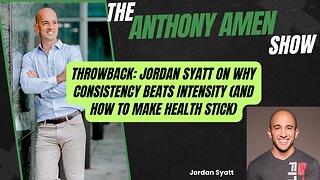Premium Only Content

Intermittent Fasting: Fact vs. Fiction
Skyrocketing in popularity over the last five years, intermittent fasting has positioned itself as the diet trend du jour. But beyond the simple concept of timing your meals within specific windows, does this approach deliver on its promises?
This deep dive explores what research actually tells us about intermittent fasting versus traditional calorie restriction. Spoiler alert: when calories are equal, the results are identical. We tackle common misconceptions about metabolism slowing, optimal protein timing, and who should think twice before jumping on the fasting bandwagon.
The protein puzzle proves particularly interesting – your body can only use about 30-40 grams of protein for muscle synthesis at once, no matter how much you consume in a sitting. This creates a fundamental conflict with many fasting protocols that limit eating windows. For those seeking muscle gain or retention (which should be everyone looking for sustainable weight management), spreading protein intake across 3-4 daily meals provides significantly better results than cramming it all into one or two meals.
Women face unique challenges with intermittent fasting, as it can wreak havoc on hormonal balance, especially during menopause. Meanwhile, those with eating disorder histories might find fasting provides a socially acceptable mask for unhealthy behaviors. But it's not all negative – people struggling with insulin resistance or lacking structure around nighttime eating might benefit from strategic meal timing.
Whether you're currently fasting, considering it, or skeptical about the whole concept, this evidence-based breakdown helps you make informed decisions about your nutrition approach. Share this episode with friends contemplating intermittent fasting – because fitness truly is medicine, but only when applied correctly.
-
 36:40
36:40
The Anthony Amen Show
3 days agoThrowback: Jordan Syatt on Why Consistency Beats Intensity (And How to Make Health Stick)
71 -
 2:00:58
2:00:58
MG Show
18 hours agoFBI’s CRIMINAL RAID on Mar-a-Lago Confirmed; Rob Reiner BEHIND Russia Collusion?
20.1K14 -
 1:00:18
1:00:18
Dialogue works
2 days ago $0.82 earnedLarry C. Johnson: Russia Launches Largest Missile & Drone Attack Yet
2.48K6 -
 12:02
12:02
Actual Justice Warrior
1 day agoChicago Mayor Says ONLY Black Businesses Get Licensed
13.6K25 -
 4:21
4:21
SethDrums
4 days ago50 Cent - In Da Club if it was 1950s
12.2K3 -
 1:48:49
1:48:49
Badlands Media
15 hours agoDevolution Power Hour Ep. 416: The Rug Pull Cycle, False Signals & Narrative Discipline
376K44 -
 1:06:11
1:06:11
Inverted World Live
15 hours agoA Ghost Ship in Washington, A Fire in Roswell | Ep. 155
77.8K15 -
 3:06:55
3:06:55
TimcastIRL
10 hours agoDan Bongino To RESIGN, Trump Addresses The Nation
368K559 -
 2:14:08
2:14:08
Barry Cunningham
10 hours agoLIVE BREAKING NEWS: President Trump Addresses The Nation! And More News!
66.1K30 -
 5:15:27
5:15:27
ThatStarWarsGirl
12 hours agoTSWG LIVE: Discussing STAR WARS News with Special Guest Star Wars Theory!
52.1K5